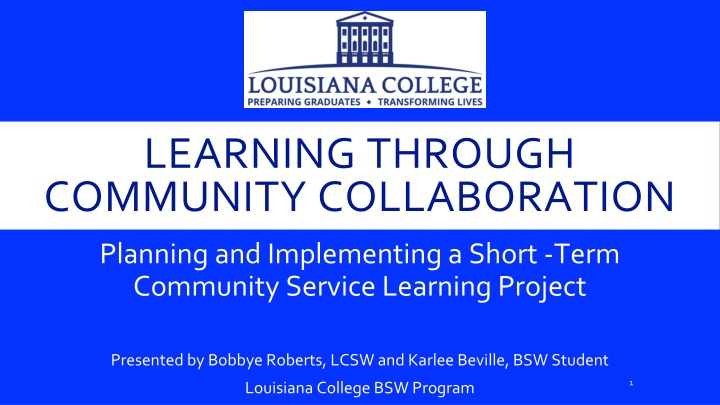
Planning and Implementing a Short-Term Community Service Learning Project
Engage in community collaboration to address social problems through a structured approach involving research, analysis, hypothesis development, and creative interventions, supported by community collaborations and partnerships.
Download Presentation

Please find below an Image/Link to download the presentation.
The content on the website is provided AS IS for your information and personal use only. It may not be sold, licensed, or shared on other websites without obtaining consent from the author. If you encounter any issues during the download, it is possible that the publisher has removed the file from their server.
You are allowed to download the files provided on this website for personal or commercial use, subject to the condition that they are used lawfully. All files are the property of their respective owners.
The content on the website is provided AS IS for your information and personal use only. It may not be sold, licensed, or shared on other websites without obtaining consent from the author.
E N D
Presentation Transcript
LEARNING THROUGH COMMUNITY COLLABORATION Planning and Implementing a Short -Term Community Service Learning Project Presented by Bobbye Roberts, LCSW and Karlee Beville, BSW Student 1 Louisiana College BSW Program
SOCIAL WORK MACRO PRACTICE 6TH ED. Netting, Kettner, McMurtry, Thomas ***Adapted and excerpted from this text 2
WHY SERVICE LEARNING? Engages community partners Engages students in Macro Practice Integrates faith into action 3
PLANNED CHANGE Rational Planning Approach Logic Model Inputs, Outputs, Outcomes, Impact 4
IDENTIFY A SOCIAL PROBLEM AND STUDY THE NEED FOR CHANGE Collaborate with local agencies to identify a problem within the community Problem Population Arena 5
RESEARCH AND ANALYSIS Students Explore the Professional Knowledge Base peer reviewed literature data and statistical information (quantitative and qualitative) 6
HYPOTHESIS OF ETIOLOGY Identify and List: Causal factors Related results/outcomes 7
DEVELOP THE INTERVENTION HYPOTHESIS What interventions are implied in the hypothesis of etiology? Cause and Effect Relationship If the following interventions are implemented: 1) 2) 3) The following results can be expected: 1) 2) 3) 8
BRAINSTORMING CREATIVE INTERVENTIONS Based on hypothesis of etiology, students brainstorm several possible relevant interventions Students rank order the most feasible to accomplish in a limited time frame Student must agree as a group 9
BUILDING SUPPORT: COMMUNITY COLLABORATIONS DEFINE KEY PARTICIPANT/SYSTEMS ASSESS SUPPORT AND OPPOSITION Initiator System Change Agent System Client System Support System Controlling System Host System Implementing System Target System 10
SELECT A CHANGE APPROACH Project Approach (short-term) Other possible approaches: policy; program; practice 11
SELECT STRATEGIES AND TACTICS FOR INTERVENTION Strategies overall efforts used to ensure change effort is a success involve long-range linking of actions Collaborative Strategies and partnerships Tactics specific techniques and behaviors that the strategy employs 12
SET GOAL FOR INTERVENTION What is the Overall Outcome Expected? 13
WRITE OUTCOME OBJECTIVES Set an initial time frame: Day, Month, or Year when initial results can be seen Set a future time: A point in future when measurable results may be seen from the intervention Who or what group will experience a quality of life change from the intervention? What changes are expected for the target population from this intervention? 14
WRITE PROCESS OBJECTIVES Establish a time frame for specific actions to take place for the specified objective Who or what will be the focus of this objective? What will be the evidence that this objective has been achieved? 15
LIST ACTIVITIES FOR PROCESS OBJECTIVES What When Who is responsible for each activity? 16
INITIATE THE ACTION PLAN Manage Logistics: Facilities, Equipment, Resources, Personnel PERT Chart/ Flow Charts 17
MANAGING, TRAINING AND PRACTICING Who will act as the leader or manager keeping the project on track? Will the intervention involve training any volunteers? Will the intervention require preparations such as practicing a presentation, etc.? 18
MONITORING AND EVALUATION Process Evaluation tracking process objectives Outcome Evaluation tracking outcome objectives interpreting results and accurate conclusions cost versus benefits 19
CHALLENGES OF COMMUNITY SERVICE LEARNING IN A MACRO PRACTICE COURSE Limited time frame to research, plan and implement project may hinder collaborative efforts Guarding against risk of harm Risk of not doing enough; Although, most collaborating agencies are thankful for volunteers/students efforts 20
REWARDS OF COMMUNITY SERVICE LEARNING IN A MACRO PRACTICE COURSE Students creative and thoughtful planning of and active engagement in macro practice Reward of positively impacting the community Reward of putting faith into action: David Livingston: Sympathy is no substitue for action. 21
REFERENCES Gardinier, L. (2017) Service-learning through community engagement: What community partners and members gain, lose, and learn from campus collaborations. New York, NY: Springer Publishing Company, LLC. Kirst-Ashman, K. K., Hull, G. H. (2012). Generalist practice with organizations and communities. (5th ed.) Belmont, CA: Brooks/Cole. McClendon, J., Kagotho, N., & Lane, S.R. (2016). Preparing social work students for leadership in human service organizations through student philanthropy. Human Service Organizations, Management, Leadership & Governance, 40, 500-507. doi: 10.1080/23303131.2016.1173159 Netting, F. E., Kettner, P. M., McMurtry, S. L., & Thomas, M. L. (2017). Social work macro practice (6th ed.) Boston, MA: Pearson Education. Ramson, A.J. (2014). Service-learning: A tool to develop employment competencies for college students. Journal on Excellence in College Teaching,25(1), 159-187. Retrieved from http://search.ebscohost.com.lacollegelibrary.idm.oclc.org/login.aspx? direct=true&db=eric&AN=EJ1026187&site=ehost-live Stoecker, R. & Tryon, E. A. (2009). The unheard voices: Community organizations and service-learning. Philadelphia, PA: Temple University Press 22
